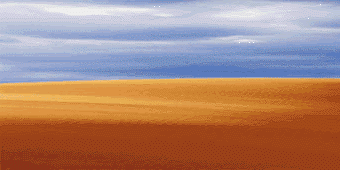
|
Reportage | |
|
From Damascus to Edessa
Travelogue of a visit to Syria and Turkey by Ute Possekel Hugoye: Journal of Syriac Studies, Vol. 12.1, 135-165 © 2009 by Beth Mardutho: The Syriac Institute and Gorgias Press Since ancient times, people have traveled to Syria from the West. Merchants have come to trade and geographers to survey the land, intellectuals have come to learn and pilgrims to visit holy sites. In March of 2008, our group of fifteen scholars from Northern Europeand the United States, expertly led by Inga-Lill and Samuel Rubenson (Lund University), followed in their footsteps to discover and experience the East. We gathered at Copenhagen airport on a cold morning and embarked on a flight to Damascus, where we were met by our local guide and driver. As we passed through Damascus on this quiet Friday afternoon, we watched local families everywhere enjoy the warm spring weather, picnicking in the parks and olive groves that line the streets, and we even caught a glimpse of the city walls through which the Apostle Paul is said to have escaped (Acts 9:25; 2 Cor. 11:32–33). Leaving the city behind, the bus slowly wound its way up into the mountains towards our first night’s destination, the small town of Ma’aloula, some 60 km north of Damascus. This town, nestled in the foothills of the Anti-Lebanon mountains, is inhabited by a largely Christian population that prides itself on being the only remaining Aramaic-speaking communityin Syria. In addition to its linguistic fame, Ma’aloula attracts visitors on account ofan ancient church and a pilgrimage site associated with Thecla. | ||
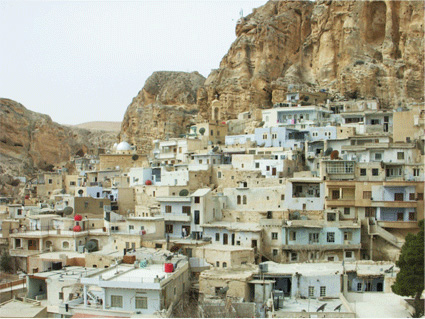
photo 1: Ma’aloula | ||
|
We awoke the next morning to a stunning view of the Anti-Lebanon mountain range and of the colorful village houses built right into the hillsides. Some of us attended the morning liturgy in the ancient church of St. Sergius. Later, the entire group returned to see the building in more detail. The church is named after the early Christian martyr-saints Sergius and Bacchus, said to have been soldiers at the Roman frontier who were executed during the reign of Diocletian after refusing to sacrifice to the pagan gods. The main cult center of Sergius in antiquity was Rusafa, a Roman garrison town located in the desert further to the north-east and identified as the place of his martyrdom. The church in Ma’aloula testifies to the popularity of Sergius’ cult throughout the Syrian region.
The church of St. Sergius is of great antiquity and said to have survived earthquakes on account of its architectural design, which integrates horizontal layers of wood into the masonry structure. The object of greatest interest here is an altar with a marble top, shaped like a horse-shoe with a raised edge. This altar was apparently modeled upon pagan altars — the raised edges functioned to contain the blood of sacrificed animals — but unlike its pagan counterparts the altar top in St. Sergius lacks the typical opening which allowed the sacrificial blood to flow down. The local Christian who proudly showed us the church maintained that this unique altar must precede the Council of Nicaea in 325, claiming that a Nicene prohibition of sacrifice resulted in flat altar tops; however, a review of the council canons cannot sustain this claim. And while this altar certainly appears quite ancient and its shape rather unusual, it is not unique, for in the museum of Apamea is displayed a nearly identical piece (there labeled as a table top). Our Christian guide of St. Sergius concluded her tour with a recitation of the Lord’s Prayer in her Aramaic mother tongue. From the church of St. Sergius, we proceeded to the town’s second major attraction, a shrine dedicated to Thecla. The path led through a deep gorge, dotted on both sides with caves and empty tombs. At the end of the gorge stand the church and monastery of St. Thecla. According to the Acts of Paul and Thecla, Thecla escaped a group of pernicious suitors by taking refuge in a crack that miraculously opened up in the rock and immediately closed again after her. This church was built around the very cave believed to have been the site of this miracle. Thecla’s tomb is venerated in a niche of the cave, and votive offerings give testimony to her healing power and to the local Christian devotion to this saint. | ||
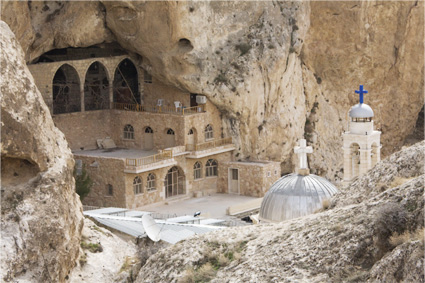
photo 2: Monastery of St. Thecla | ||
|
From Ma’aloula, we turned East into the Syrian desert towards Palmyra. Soon we left behind the olive groves and villages, and in front of our eyes extended the vast, beautiful steppe region, seemingly limitless, that for centuries marked the shifting frontier between Rome and Persia. The only vegetation consists of little tufts of dry grass here and there — enough, however to sustain the sheep and camels of the nomad tribes.
After several hours we stopped at the one and only modern oasis on the road to Palmyra, a restaurant called the Baghdad Cafe 66 after the 1988 movie of the same name. Here we rested, as travelers might have done ages ago, sitting down in the tent-like structure where a family of former Bedouins served a delicious lunch. In the late afternoon we reached the greatest oasis of the Syrian desert — and one of the most grandiose cities of antiquity — Palmyra. The oasis came into sight first: palm trees, olive groves, and lush gardens of fruit and vegetables, all surrounded by mud walls to keep out the roaming animals of the steppe. | ||
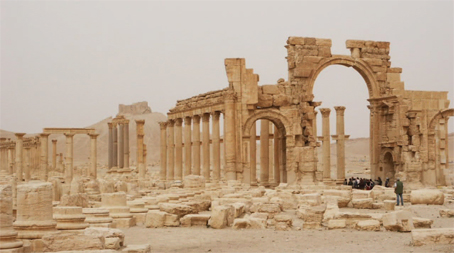
photo 3: Palmyra, Monumental Gate | ||
| Then, all of a sudden, we found ourselves in front of the monumental gate to Zenobia’s city. Beyond the gate extend long, colonnaded streets, baths, theatre and agora, temples, remains of residential neighborhoods, Roman military camps, and Christian churches: an entire city indeed, vaster than one imagines and much more magnificent. We explored the ruins until after the sun had set behind the valley of the tombs beyond the western wall. When night fell upon the desert, the terrace of the Hotel Zenobia (built right in the middle of the archaeological site!) offered us refreshments and a stunning view of the temple of Baal-Shamin. | ||
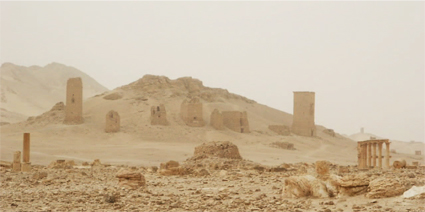
photo 4: Palmyra, Tomb Towers | ||
| Palmyrene history, culture, and religion are discussed in many publications and need not be dwelled on here, but perhaps a few words on the Christian remains are in order. Two churches have been identified. The first of these is located just north of the main East-West colonnade, or cardo, about half way between the tetrapylon and Diocletian’s camp. This church is of modest size, built in basilica style with an apse on the East side. Near the apse, there seem to have been wells, but it was unclear to us when they were constructed and what purpose they may have served. | ||
 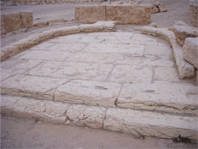
photo 5: Palmyra, Fragment of a Church building photo 6: Palmyra, Apse of Church | ||
|
The second church is located a bit further to the north east and much larger in size, perhaps indicating a later time of construction. This building likewise has basilica shape with the apse on the East side. The excavators dug a trial trench, and future archaeological research may bring to light further details of this (presumably Byzantine) edifice. There is a third building, just off the cardo to the north, that by some has been judged to be a Christian house of worship on account of its apse. However, the general layout of the building did not to our group appear to support this conjecture. But since large sections of Palmyra still lie hidden underneath the rubble, it is not impossible that future excavations might bring to light more traces of its early Christian community.
The night was spent in a hotel near the oasis, and the morning light brought once again a surprising view: from the breakfast room on the hotel’s upper floor we had amagnificent prospect of the ancient ruins, especially the gigantic Temple of Bel, and of the modern town. An early morningstroll through the oasis provided us insight into the agricultural techniques of growing food in the steppe, as well as intoone of the preferred pastimes of the Palmyrenes: a large soccer field is situated within the grove of palm trees. We started our day with a visit to several of the many dozens of ancient tombs. The wealthy Palmyrene families buried their dead either in tomb towers, a type of funerary monument unique to the Euphrates region, or in hypogaea (underground tombs), or in tomb temples. The less affluent, we may surmise, buried their deceased in unmarked graves that have not left any traces. In many of the tomb towers and hypogaea, stunningly beautiful reliefs of the deceased decorate the loculi, the spaces in which the buried were placed. Time allowed us to visit only two of these tombs. The tomb tower of Yambliqu, dated by an inscription to the year 83 AD, was originally five stories high and provided space for about 200 interments. Today the visitor can still climb up to the fourth floor; however, the extraordinary funerary reliefs that once adorned the tombs have been removed to museums in Palmyra and Damascus. Next we visited the Hypogaeum of the Three Brothers, constructed in the second century, which offered space for more than three hundred of the family’s deceased. Its interior is accessible through ancient stonedoors and has the layout of an upside-down T. The section directly in front of the visitor is beautifully decorated with wall paintings, whereas the side chambers contain sarcophagi with marvelously carved family banquet scenes. | ||
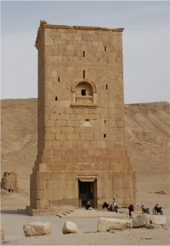 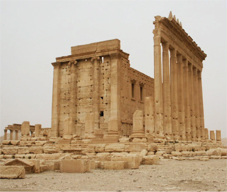
photo 7: Palmyra, Tomb Tower of Yambliqu photo 8: Palmyra, Cella of Temple of Bel | ||
|
We then returned to the western part of Palmyra and explored its largest and most imposing monument, the Temple of Bel, which in its current form was dedicated in 32 AD. The vast temple enclosure, the temenos, measures approximately 205 by 210 meters and is surrounded by a massive wall 11 m high. Inside this wall there is a single row of columns on the entrance side to the west, and a double row of columns on the other three sides. One can easily imagine how the entire Palmyrene population might have gathered here for rituals and sacrifices. Clearly visible still is the tunnel through which the sacrificial animals were led into the temenos, the benches where the populace sat and watched, the washing basin for the priest, the altar and its elaborate underground tunnel system, and the remains of a hall where the sacrificed animal was consumed by priests and special guests. In order to attend such a ceremonial meal, guests were required to have “invitation cards”, little clay tokens now on display in the museum. The enormous temple cella, where only the priests were permitted to enter, still dominates the site. Its interiorand exterior is beautifully decorated with relief carvings. In the northern niche of the cella, the ceiling relief is surrounded byazodiac circle, reminiscent of synagogue decorations in late antiquity. At some point in time, the cella was used by Christians as a sanctuary, for remains of their wall paintings are still noticeable. Later, the site became a mosque, and once again it is the stone walls that witness to this usage with their Arabic inscriptions.
The Archeological Museum of Palmyra is not to be missed, for it displays many of the remarkable funerary reliefs, pagan altars coins, and other finds from Palmyra’s past, including several mummies. Quite interesting are funerary representations of a woman holding a small child, anticipating the later Christian iconography of Mary and Jesus. The many Palmyrene inscriptions in the museum’s collection are neither translated nor transliterated in the exhibition halls, but those interested in epigraphy — or simply in learning the names of those immortalized in stone — may consult a small publication by M. Gawlikowski, which can be obtained in the shop in the theatre of Palmyra. Before our departure, we had time for one last stroll through this most magnificent of ruined cities, down the colonnaded streets, past the restored theatre and the tetrapylon, to the temple of Allath and the watch tower of Diocletian’s camp, whence one has an amazing view of the entire field of ruins, columns, and tumbled-down Palmyrene inscriptions. In the afternoon we set out into the desert once more, traveling eastwards towards the Euphrates. In the distance, there were the flocks and dark tents of the Bedouins. When a large herd of camels came into view, the bus stopped and we paused to observe these animals that we do not usually have occasion to encounter in their natural habitat. The camels moved ever closer to us, as their nomad owners were shepherding them across the busy road towards different pastures. We greeted the passing Bedouins, whose lives differ so fundamentally from ours, and they welcomed us with the kind hospitality of the desert, offering us to taste their camel milk: it was warm, creamy, and delicious. | ||
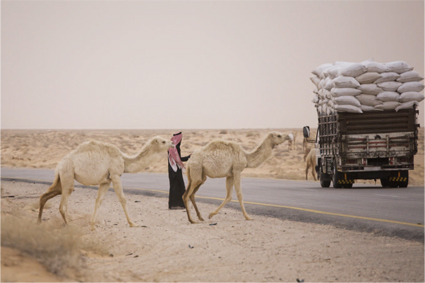
| ||
continue to read the full Travelogue.
| ||

Karavanen Fredsgatan 4 243 30 Höör |

 0413-204 29 0413-204 29
|